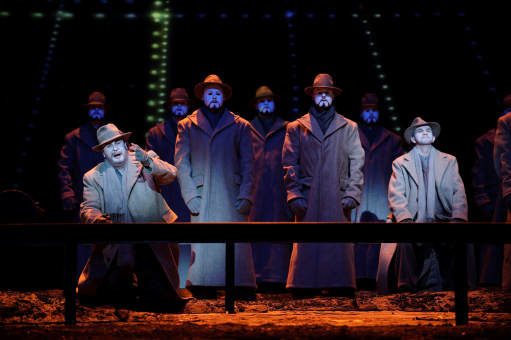Other Links
Editorial Board
- Editor - Bill Kenny
Founder - Len Mullenger
Google Site Search
SEEN
AND HEARD INTERNATIONAL OPERA REVIEW
Busoni, Doktor Faust: Soloists, Real Orquesta Sinfónica de Sevilla. Coro de la Asociación de Amigos del Teatro de la Maestranza y Coro Intermezzo. Conductor: Pedro Halffter. Teatro de la Maestranza de Sevilla. 21.10.2008. (JMI)
Production. Staatsoper Unter den Linden. Berlin.
Director: Peter Mussbach.
Sets. Erich Wonder.
Costumes: Andrea Schmidt-Futterer.
Lighting:
Alexander Koppelmann.
Within a few days I had the opportunity to attend three opera
performances that have several points in common. All of them were
opening opera seasons, were composed in the first half of the last
century and, finally, they are three magnificent musical works. I am
referring to Toulouse’s Capitole, Barcelona’s Liceu and now
Seville’s Maestranza. If the French city opened with Enescu’s
Oedipus, and Liceu’s choice was Tiefland, Seville
decided to open with Busoni’s Doktor Faust, a real success in
musical and stage terms. Three wonderful operas, hardly performed in
Spain. In fact, this Seville’s Doktor Faust is the first ever
Spanish performance, arriving here a modest 80 years late.
Cast:
Faust: Christopher Robertson.
Mefistófeles: Robert Brubaker.
Duchess of Parma: Mary Mills.
Wagner: Matthias Hölle.
Duke of Parma: José Ferrero.
Soldier: Mirko Janiska.

The production comes from Berlin’s Staatsoper Unter den Linden of
Berlin, where it was premiered two years ago. Peter Mussbach’s work
in this production seems to me his most interesting creation up
until now. He offers a timeless, unreal, and I dare to say dream
like vision of the action, with careful balance between the
aesthetic elements and careful direction of the actors and chorus.
Mussbach starts to fly high in Marguerite’s brother confession
scene, a most original and attractive scene in the Duke of Parma’s
palace, where the historical characters appearing on stage are
nothing less than Parma’s Duchesses. The scene in the Wittenberg
tavern with its philosophical-religious discussion is one of the
best examples of stage direction I have ever seen. This is a modern
production, full of imagination, and a pleasure to the eye.
Pedro Halffter seems to find his natural territory in 20th
century opera as we could heard in his outstanding versions of
Der Ferne Klang and Krenek’s Orpheus und Euridike. This
time he produced a very good performance of Doktor Faust
particularly in the second part where he was wonderful. His
orchestra gave him excellent playing sharing the success with their
conductor. The huge chorus that this opera requires was very well
managed too.
This opera requires two great protagonists (Faustus and Mefistófeles),
another two of relative importance (Wagner and the Duchess of Parma)
and numerous secondary characters. The demands were not wholly met.
Doctor Faustus is a baritone here and was interpreted by
Christopher Robertson, who was slightly in vocal terms. He lacked
vocal power for the role and his voice was poorly projected,
scarcely audible in fact when singing from the front of the stage.
Mefistófeles is a tenor and Robert Brubaker offered a very complete
interpretation of the role. He was most convincing, and probably
produced the best work I have ever seen from him.
Mary Mills was an excellent Duchess of Parma. This soprano is
unjustly forgotten by the big opera houses: she is a good singer,
with an interesting lyric soprano and is also an outstanding
actress. Her greatest problem has always been her top register, but
in this role the tessitura is not too high.
Veteran bass Matthias Hölle doubled as Master of Ceremonies
and Wagner. Sadly, his voice is just a shadow of what it was.
In the secondary roles Jose Ferrero was a good Duke of Parma, and
Mirko Janiska, an interesting soldier (Valentin in Gounod’s Faust).
The house had some empty seats which
increased in number after the intermission and at the end of the
more than three hours, many in the audience left the theatre in a
rush.. Those who remained gave a very warm reception to the
artists, with nothing less than triumphs for Pedro Halffter and
Robert Brubaker.
Jose M. Irurzun
Back
to Top
Cumulative Index Page
